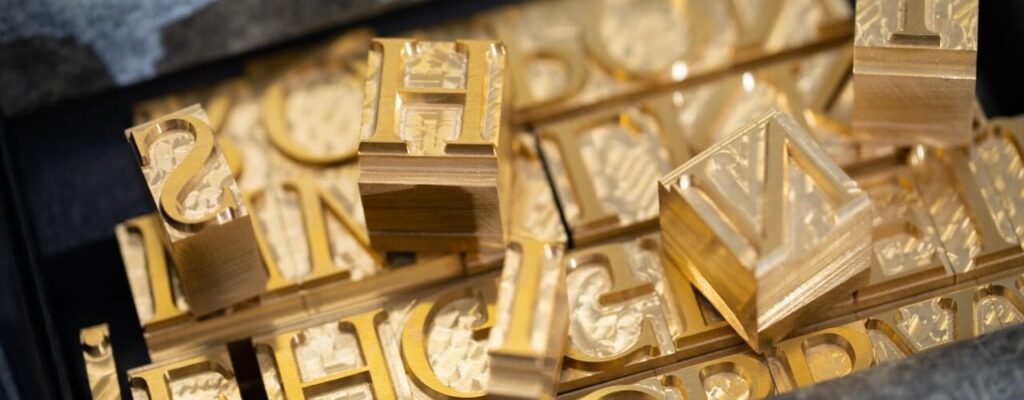

Renowned for its tactile and elegant results, letterpress printing involves pressing inked type or images onto paper, creating a visual and physical impression. This guide will delve into the fascinating process of letterpress printing, highlighting each step and showcasing why it remains a cherished method for printing.
What is Letterpress Printing?
Letterpress printing is a relief printing process in which a raised surface is inked and then pressed onto paper or another substrate to transfer the ink. The result is a print with a distinct impression that you can both see and feel. This method was the standard form of printing until the mid-20th century when offset printing became more prevalent. Today, letterpress is prized for its craftsmanship and the unique, high-quality prints it produces.
The History of Letterpress Printing
Letterpress printing originated with Johannes Gutenberg’s invention of the movable type printing press around 1440. This innovation allowed for the mass production of books, making literature more accessible and affordable. While the techniques have evolved over the centuries, the basic principles remain unchanged.
Tools and Materials Used in Letterpress Printing
Types and Plates
Letterpress type can be metal or wood. Metal type is durable and precise for detailed text, while wood type suits larger, decorative fonts. Modern letterpress often uses photopolymer plates from digital designs for intricate graphics and text.
Inks
Letterpress inks are typically oil-based, providing rich, vibrant colours and a long-lasting finish. Eco-friendly and water-based inks are also available to meet various needs.
Presses
Types of letterpress presses include platen presses for small, intricate print runs and cylinder and flatbed presses for larger projects.
Paper
Thick, soft papers that can take a deep impression are ideal for letterpress printing. Cotton papers are especially popular for their durability and luxurious feel.
The Letterpress Printing Process
1. Designing the Artwork
The first step in letterpress printing is designing the artwork, either digitally with graphic design software or manually with traditional methods. Consider the process’s limitations and strengths, like deep impressions and potential variations in ink coverage.
2. Creating the Plate
Once the design is finalised, a plate is created. Traditional metal or wood type involves setting the type by hand. For photopolymer plates, the digital design is transferred using a UV exposure process, creating a raised surface for inking and pressing onto the paper.
3. Preparing the Press
The press is prepared by setting the plate and inking rollers. Ink amount and pressure are carefully calibrated to ensure high-quality prints. A skilled operator adjusts the impression roll for a ‘kiss’ touch, balancing pressure to avoid squashed or missing dots.
4. Printing
With the press ready, the paper is positioned, and the plate is pressed onto it. This may be repeated for multi-colour designs, with each colour requiring a separate plate and pass through the press. Each print is unique due to the tactile nature of letterpress printing.
5. Drying and Finishing
Printed materials need time to dry, especially with oil-based inks, taking several hours to days. Once dry, prints can be enhanced with additional processes like die-cutting, embossing, or foil stamping.
Advantages and Disadvantages of Letterpress Printing
Advantages
Superior Quality and Aesthetic Appeal: Letterpress printing offers a luxurious, timeless look with deep impressions and rich ink coverage.
Durability: The ink is deeply pressed into the paper, making prints less likely to smudge or fade. This makes them ideal for keepsakes like wedding invitations and business cards.
Eco-Friendly Options: Many printers use recycled paper, soy-based inks, and sustainable materials, and the durability of prints reduces the need for reprinting.
Disadvantages
Cost: Letterpress printing is more expensive due to its labour-intensive process and material costs. Each colour requires a separate plate and passes through the press.
Limited Colour Range: Typically limited to spot colours, making it less suitable for full-colour projects.
Setup Time: The setup process is more time-consuming, making it less ideal for short print runs or tight deadlines.
Principles of Letterpress Printing
Letterpress printing is based on relief printing, where the image to be printed is raised above the non-printing areas. Ink is applied to this raised surface, and pressure transfers the ink onto the paper. Key principles include:
- Pressure: The right amount of pressure affects the depth of the impression and print quality. Too much pressure can damage the paper, while too little results in incomplete ink transfer.
- Ink Coverage: Achieving high-quality prints requires consistent ink coverage, which involves careful calibration of the inking rollers and ink amount.
- Registration: Accurate registration is crucial for multi-colour prints. It ensures that each colour aligns correctly, preventing misalignment and overlap.
Label Press Configurations Used for Letterpress Printing
Label presses used for letterpress printing are designed to handle the high demands of label production. These presses can vary in configuration but generally include features such as:
- Rotary Letterpress: Rotary letterpress machines use cylindrical plates and continuous rolls of paper. This configuration allows for high-speed printing and is ideal for large print runs.
- Inline Finishing: Many label presses include inline finishing capabilities such as die-cutting, embossing, and laminating. This streamlines the production process and allows the creation of finished labels in a single pass.
- UV Curing: UV curing systems are often integrated into modern label presses. These systems use ultraviolet light to cure the ink instantly, allowing for faster production and improved durability of the printed labels.
Letterpress printing is more than just a printing technique; it is an art form that combines precision, skill, and creativity. From the design stage to the final printed piece, every step is a testament to this traditional method’s enduring appeal and unmatched quality. Whether you are a designer or a business owner, letterpress printing offers a unique and timeless option for your printing needs.